Discover the art of Birrittella pizza dough baking. Learn proofing, stretching, and baking techniques for perfect results. Expert guidance ensures delicious homemade pizzas every time.
Overview of Birrittella Pizza Dough
Birrittella pizza dough is known for its elastic texture and flavorful profile. It requires precise proofing and stretching techniques to achieve the perfect crust. Proper fermentation and handling ensure a light, airy base. Expert guidance helps master the dough’s preparation, from slow fermentation to room-temperature stretching. This dough is ideal for homemade pizzas, offering a delicious balance of crunch and chew when baked correctly.
Importance of Proper Baking Techniques
Proper baking techniques ensure a perfectly cooked crust and even flavor distribution. Preheating the oven to the right temperature is crucial for achieving a crispy base. Allowing the dough to rest before shaping prevents shrinkage. Even baking prevents hot spots, while proper timing enhances browning. These steps ensure a professional-quality pizza with a delicious crust and perfectly cooked toppings every time.
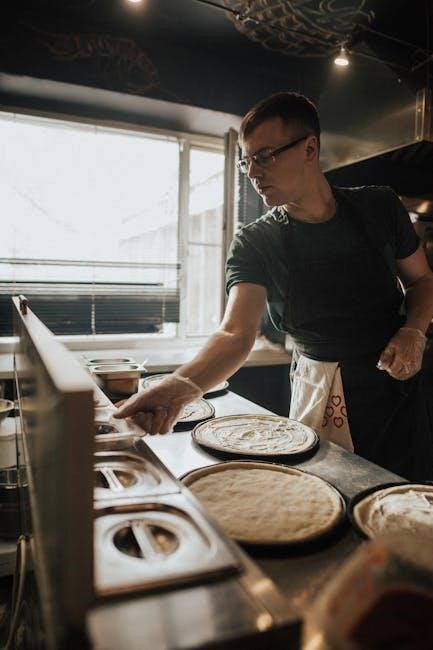
Understanding the Ingredients
Mastering Birrittella pizza dough begins with quality ingredients. High-protein flour ensures elasticity, while yeast ferments for a light texture. Water and salt balance hydration and flavor, creating a versatile dough for perfect pizzas.
Flour Selection for Pizza Dough
Flour is the cornerstone of pizza dough. High-protein flour, like bread flour or Caputo, provides elasticity and structure. Its strength ensures a chewy crust and proper rise during fermentation. Avoid all-purpose flour for weaker gluten. The right flour choice enhances dough flexibility, making it easier to shape and stretch, while maintaining a crispy crust texture that defines authentic pizzas. Proper flour selection elevates the overall quality of your Birrittella pizza dough.
Role of Yeast in Dough Fermentation
Yeast is a vital ingredient in pizza dough, driving fermentation. It converts sugars into carbon dioxide, causing the dough to rise. Proper yeast activation ensures a light, airy texture. Slow fermentation in the fridge enhances flavor depth, while room-temperature proofing accelerates the process. Balancing yeast activity with time and temperature is key to achieving the perfect rise and structure in Birrittella pizza dough, ensuring a crispy yet tender crust.
Water and Salt in Dough Preparation
Water hydrates the dough, creating a workable consistency, while salt enhances flavor and controls yeast activity. Using warm water (not hot) aids yeast activation. Salt is added after flour to prevent inhibiting yeast growth. The balance of water and salt ensures proper dough development, leading to a crust that is both flavorful and structured. Proper hydration and seasoning are critical for achieving the perfect texture in Birrittella pizza dough.
Necessary Tools for Pizza Dough Baking
A baking stone or steel, a high-temperature oven, and essential tools like a peel or pizza wheel are crucial for achieving perfectly baked Birrittella pizza dough.
Baking Surfaces: Stones and Sheets
A preheated baking stone or steel enhances crust crispiness by distributing heat evenly. For Birrittella pizza dough, lightly flour or oil the surface to prevent sticking. Preheating to 475°F ensures a golden-brown base. Sheets can be used but may not yield the same crust quality as stones. Always allow the dough to rest before transferring to avoid tears or stretching issues, ensuring a smooth baking process.
Oven Requirements for Pizza Baking
Preheat your oven to 475°F for optimal pizza baking. Use a pizza stone or steel inside the oven to enhance crust crispiness. Allow the stone or steel to preheat for at least 30 minutes before baking. A hot oven ensures a golden-brown crust and evenly cooked toppings. Proper preheating is essential for achieving the perfect texture in Birrittella pizza dough, making it crispy on the outside and soft within.
Essential Tools for Dough Handling
A lightly floured work surface and a dough scraper are must-haves for handling Birrittella pizza dough. A pizza peel or a sheet pan dusted with cornmeal prevents sticking when transferring dough. A clean, lightly oiled bowl is ideal for proofing, while a bench scraper helps portion and manage dough. These tools ensure smooth handling and prevent tears, making the baking process efficient and stress-free.

Preparing the Dough
Activating yeast for fermentation initiates the dough preparation. Mixing ingredients thoroughly ensures even distribution. Kneading develops gluten, creating a smooth, elastic texture essential for baking.
Activating Yeast for Fermentation
Start by activating yeast in warm water. Ensure the temperature is between 100°F and 110°F for optimal activation. Add a pinch of sugar to feed the yeast, promoting fermentation. Stir gently and let it sit until frothy, typically 5-10 minutes. This step ensures the yeast is alive and ready to ferment the dough effectively, leading to a light, airy texture in the final product.
Mixing the Dough Ingredients
Combine flour, yeast mixture, salt, and olive oil in a mixing bowl. Gradually incorporate the dry ingredients into the wet mixture until a cohesive dough forms. Use a stand mixer with a dough hook or mix by hand. Ensure all ingredients are well-integrated but avoid overmixing. The dough should be smooth and slightly sticky. Proceed to kneading for optimal gluten development, resulting in a pliable and elastic texture ready for fermentation.
Kneading Techniques for Gluten Development
Knead the dough on a floured surface or using a stand mixer with a dough hook. Work for 10 minutes until smooth and elastic. Proper kneading develops gluten strands, enhancing dough strength and structure. Use a gentle, consistent motion to avoid tearing. Overworking can lead to toughness, so stop once the dough becomes springy and slightly shiny. This step ensures a pliable texture and even rise during fermentation.
Dough Proofing and Fermentation
Allow the dough to rise in a warm, draft-free environment for at least 3.5 hours. This process develops flavor and texture, ensuring a light, airy crust.
Proofing Environments and Time
For optimal proofing, place the dough in a warm, draft-free area, such as a pantry or oven with the light on. Allow it to rise for at least 3.5 hours. Covering with plastic wrap or a damp cloth prevents drying; Lightly oiling the dough ensures easy removal. A cooler environment can extend proofing time, enhancing flavor development. Proper proofing is key for a light, airy crust with excellent texture and structure.
Fermentation Process and Benefits
Fermentation is a biological process where yeast converts sugars into carbon dioxide, causing dough to rise. This step enhances texture and flavor. Slower fermentation at cooler temperatures deepens flavor complexity. Proper fermentation ensures a light, airy crust with excellent structure. Allow the dough to rest undisturbed during this phase for optimal results. Longer proofing times can further develop the dough’s natural yeast activity, leading to a more refined taste and texture in the final pizza.

Shaping the Dough
Shaping involves forming dough into balls and gently stretching to achieve desired shapes. Handle dough lightly to maintain structure, ensuring even thickness for perfect baking results.
Forming Dough Balls
Forming dough balls is a crucial step in pizza preparation. After the dough rises, lightly flour the surface and gently divide it into equal portions. Round each piece by folding the dough under itself, creating smooth, tight balls. Brush with olive oil to prevent sticking. Let the balls rest before shaping to ensure pliability and even thickness for baking.
Expert pizzaiola Nicole Russell emphasizes handling dough gently to maintain its structure. This step ensures the dough retains its elasticity, leading to a perfectly baked crust with a tender interior.
Stretching Dough into Desired Shapes
Stretching dough into desired shapes requires gentle handling to avoid tearing. After resting, lightly flour the dough and use a tossing-and-spinning technique to achieve uniform thickness. For a classic round pizza, toss the dough overhead or spin it on a floured surface. This method ensures even distribution and a thin crust. Let the dough relax briefly before topping to maintain pliability and prevent shrinkage during baking.
Expert pizzaiola Nicole Russell recommends bringing dough to room temperature before stretching for optimal results.
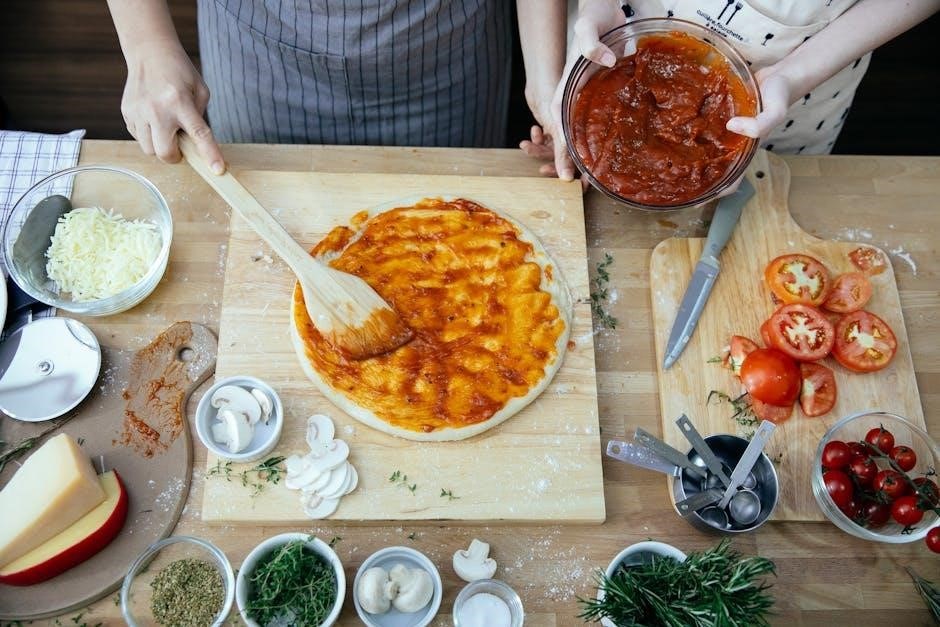
Pre-Bake Preparation
Let dough rest at room temperature to relax gluten. Lightly flour your work surface and dough to prevent sticking. Handle gently to avoid tears and maintain shape.
Letting Dough Rest Before Shaping
Allowing the dough to rest after proofing is crucial; It relaxes the gluten, making it easier to shape without tearing. Let the dough sit at room temperature for 10-15 minutes. Lightly flour the surface to prevent sticking and handle gently to maintain air pockets for a light, airy crust. This step ensures the dough retains its structure and texture, leading to a better baking result.
Stretching and Topping the Dough
After resting, gently stretch the dough on a floured surface to your desired shape. Handle with care to avoid tearing and preserve air pockets. Top with your favorite ingredients, spreading evenly. Avoid overloading, as this can make the crust soggy. Ensure the dough is at room temperature for easy stretching and a crisp, well-cooked crust. Lightly flour the dough to prevent sticking during the process.
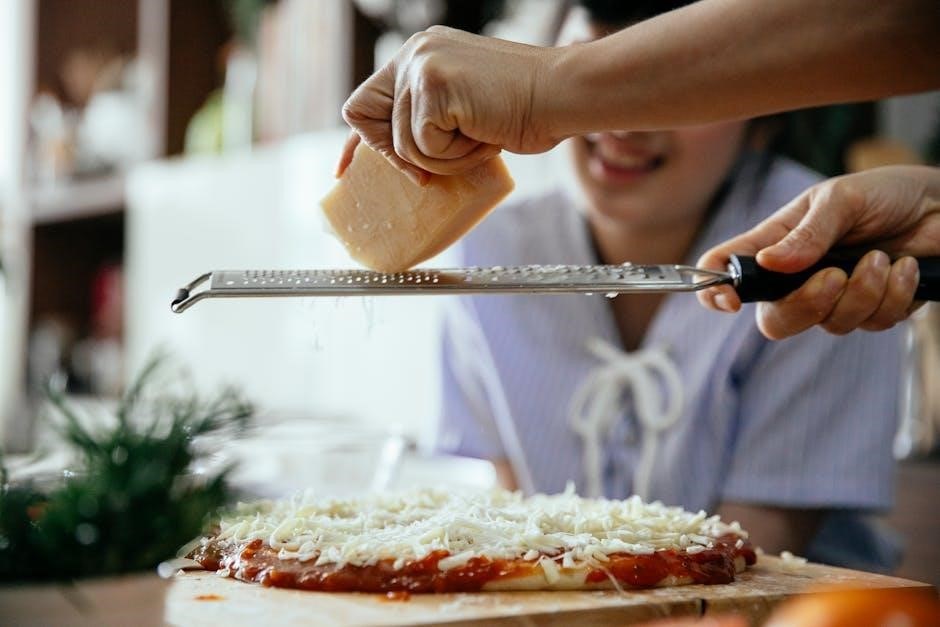
Baking the Pizza
Preheat the oven to 475°F. Place the dough on a preheated stone or baking sheet. Bake until the crust is golden and toppings are cooked through, about 10-12 minutes. Rotate halfway for even cooking. Remove carefully with a peel or spatula to avoid damage.
Preheating the Oven
Preheating the oven is crucial for achieving a perfectly baked crust. Set your oven to 475°F (245°C) and let it preheat for at least 30 minutes. A preheated oven ensures the dough cooks evenly and quickly, preventing a soggy crust. For optimal results, place a pizza stone or baking steel inside the oven while preheating to enhance crust crispiness and texture. This step is essential for a professional finish.
Baking Time and Temperature
Bake your Birrittella pizza at 475°F (245°C) for 10-12 minutes, or until the crust is golden and the toppings are cooked through. Larger pizzas may require up to 15 minutes. Ensure the oven is preheated with a stone or steel for crispiness. Monitor the pizza during the last few minutes to avoid overcooking. Proper temperature and time yield a perfectly baked crust and evenly cooked toppings for a delicious result.
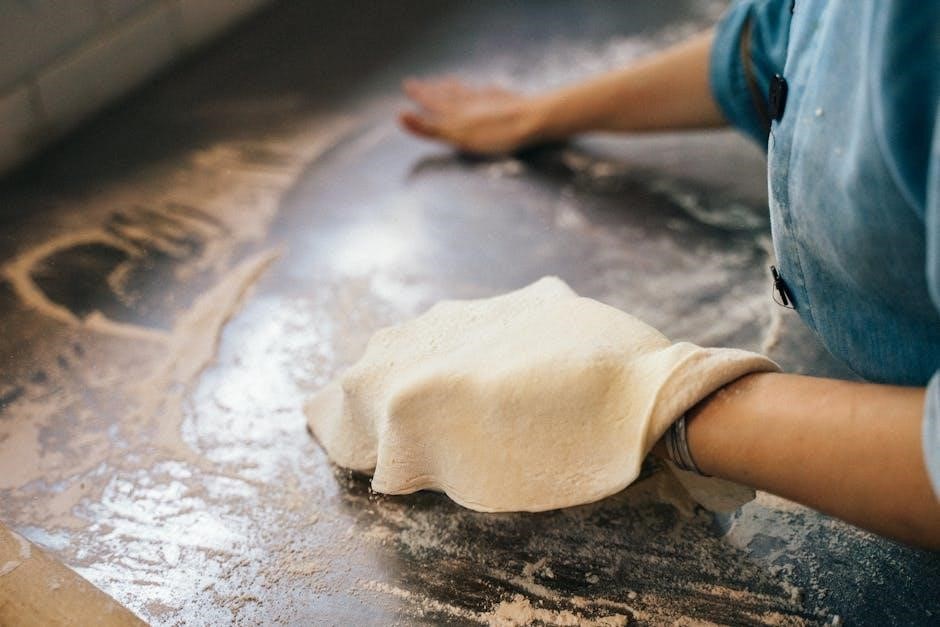
Post-Bake Care
Cool the pizza on a wire rack to prevent sogginess. Store leftovers in an airtight container in the refrigerator for up to 3 days for freshness.
Cooling the Pizza
Cooling the pizza is essential to prevent sogginess. Place it on a wire rack immediately after baking to allow air circulation. Let it rest for 5-10 minutes before slicing. This helps retain crispiness and prevents moisture buildup. For leftovers, store in an airtight container in the refrigerator within 2 hours of baking. Cooling properly ensures the crust stays firm and the flavors remain vibrant for later enjoyment.
Storing Leftover Pizza
Store leftover pizza in an airtight container in the refrigerator within 2 hours of baking to maintain freshness. For longer storage, freeze individual slices or whole pizzas in freezer-safe bags or containers. Frozen pizza can be reheated in the oven without losing texture. Ensure the pizza has cooled completely before storing to prevent moisture buildup and sogginess. Proper storage keeps your Birrittella pizza delicious for later enjoyment.
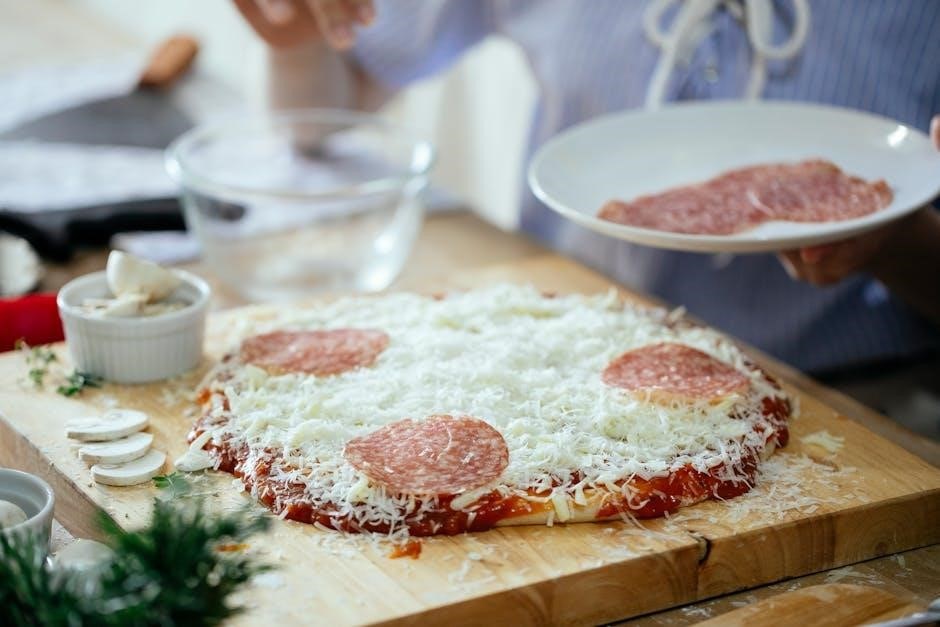
Tips and Tricks
Enhance dough flavor with olive oil and herbs; Achieve a crispy crust by preheating the oven and using a pizza stone. Monitor temperature for perfect baking results.
Enhancing Dough Flavor
Infuse your Birrittella pizza dough with extra virgin olive oil and herbs like oregano or rosemary for a aromatic flavor. Garlic butter adds a savory twist, while fresh yeast ensures a light, airy texture. Long fermentation enhances complexity, making each bite a delightful experience. Experiment with these tips to create a flavorful crust that complements your toppings perfectly.
Achieving the Perfect Crust
Preheat your oven to 475°F for a crispy crust. Allow dough to rest at room temperature before stretching. Lightly flour the work surface and dough to prevent sticking. Gently stretch dough to desired thickness without overworking. Bake on a preheated stone or sheet for even cooking. Proper fermentation and high heat ensure a golden, crunchy crust with a soft interior, perfect for any topping combination.
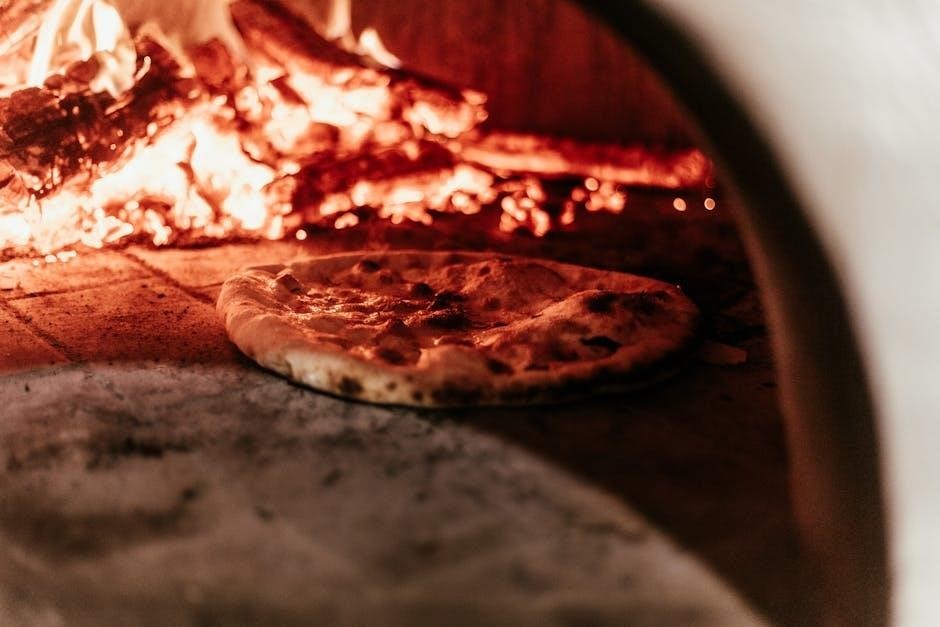
Common Mistakes to Avoid
Overworking the dough can lead to a tough texture. Ensure accurate oven temperature to prevent underbaking or burning. Avoid skipping the dough resting phase for optimal results.
Overworking the Dough
Overworking the dough is a common mistake that results in a tough, dense texture. This occurs when the gluten is overdeveloped during mixing or kneading. To avoid this, mix ingredients just until combined and knead gently. After autolyse, handle the dough minimally. Overmixing after this phase disrupts the dough’s structure, leading to a less airy crust. Proper handling ensures a light, tender base for your pizza.
- Avoid excessive mixing after autolyse.
- Knead gently to preserve dough structure.
- Overworking leads to a dense, tough crust.
Incorrect Oven Temperature
Incorrect oven temperature can significantly affect pizza quality. Preheat your oven to 475°F (245°C) for optimal results. Too low a temperature can lead to undercooked dough, while too high can burn the crust. Use an oven thermometer to ensure accuracy. Proper preheating ensures even baking and a crispy crust. Incorrect temperatures often result in uneven cooking or a soggy base. Always verify your oven’s temperature before baking for consistent results.
- Preheat to 475°F (245°C) for ideal baking.
- Too low a temperature causes undercooked dough.
- Use a thermometer for accuracy.
Mastering Birrittella pizza dough baking requires patience and practice. Follow these instructions for perfect results and enjoy crafting delicious homemade pizzas with confidence and creativity.
Final Thoughts on Baking Success
Birrittella pizza dough baking is a rewarding process that combines skill and patience. Proper proofing, stretching, and baking techniques ensure a perfect crust. Letting dough rest before shaping and using quality ingredients are key. Nicole Russell’s expert guidance demonstrates how to achieve professional results at home. With practice, you’ll master the art of creating delicious, authentic pizzas that impress family and friends. Experiment with toppings for endless flavor combinations.
Encouragement to Experiment
Embrace creativity with Birrittella pizza dough by experimenting with unique toppings and flavor combinations. Don’t be afraid to try new ingredients or techniques to make your pizza truly special. Nicole Russell’s expert tips inspire confidence to innovate while maintaining traditional methods. Remember, every bake is an opportunity to refine your craft and discover new favorites. Happy experimenting and enjoy the journey to pizza perfection!
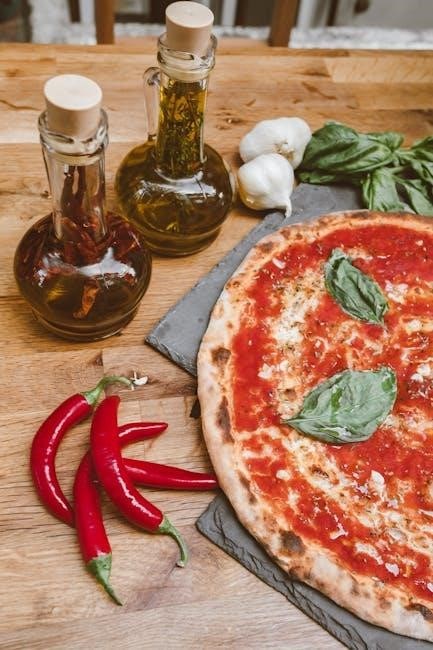
Additional Resources
Explore Nicole Russell’s tutorials on Appetito Magazine for expert guidance. Join online communities like Pizza Wars for shared tips and recipes, enhancing your pizza-making journey.
Recommended Recipes and Tutorials
Check out Nicole Russell’s step-by-step guides on Appetito Magazine for Birrittella pizza dough. Try her Chicken Parmesan Focaccia recipe and explore video tutorials on Pizza Wars. These resources offer expert tips for proofing, stretching, and baking. Follow along with detailed instructions to master dough preparation and achieve crispy, flavorful crusts; Perfect for beginners and experienced bakers alike, these tutorials ensure consistent, delicious results.
Online Communities for Support
Join online communities like Appetito Magazine’s forums and Pizza Wars discussions for expert advice and troubleshooting. Engage with pizzaiolos like Nicole Russell and fellow bakers on social media groups. Share your experiences and gain insights to refine your Birrittella pizza dough techniques. These platforms offer valuable tips, recipe variations, and support to help you master pizza dough baking and stay updated on the latest trends.